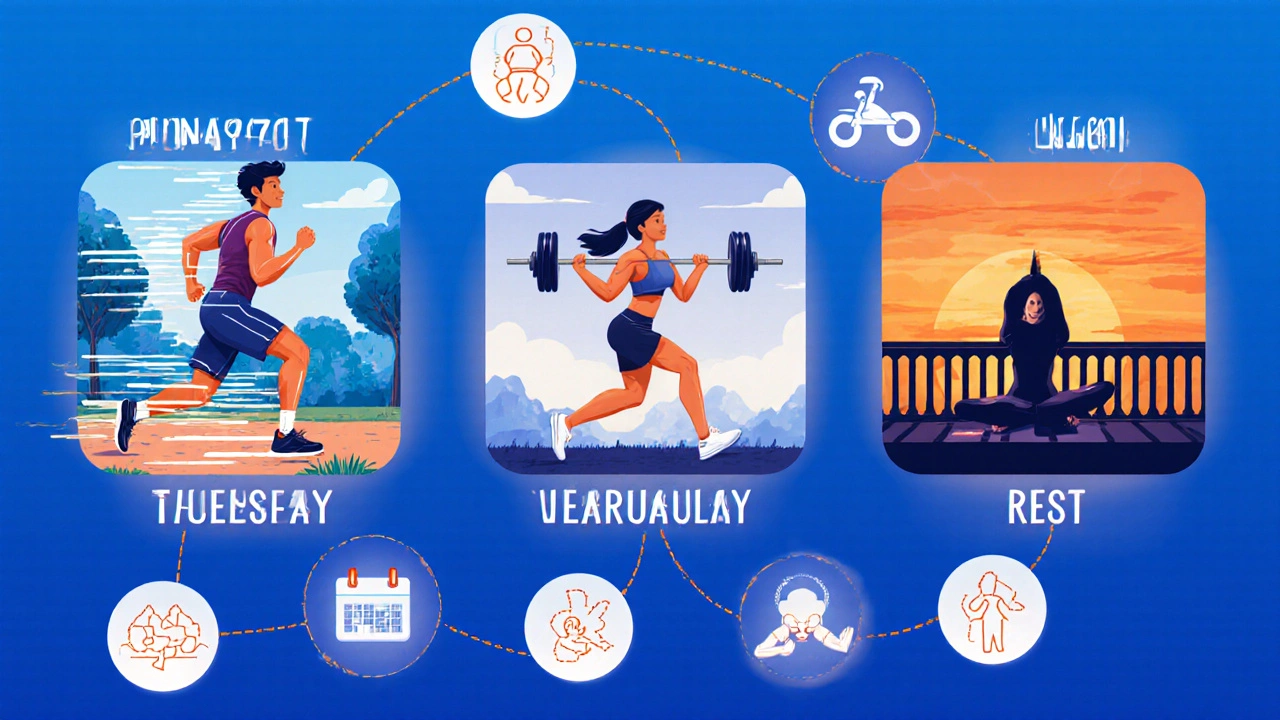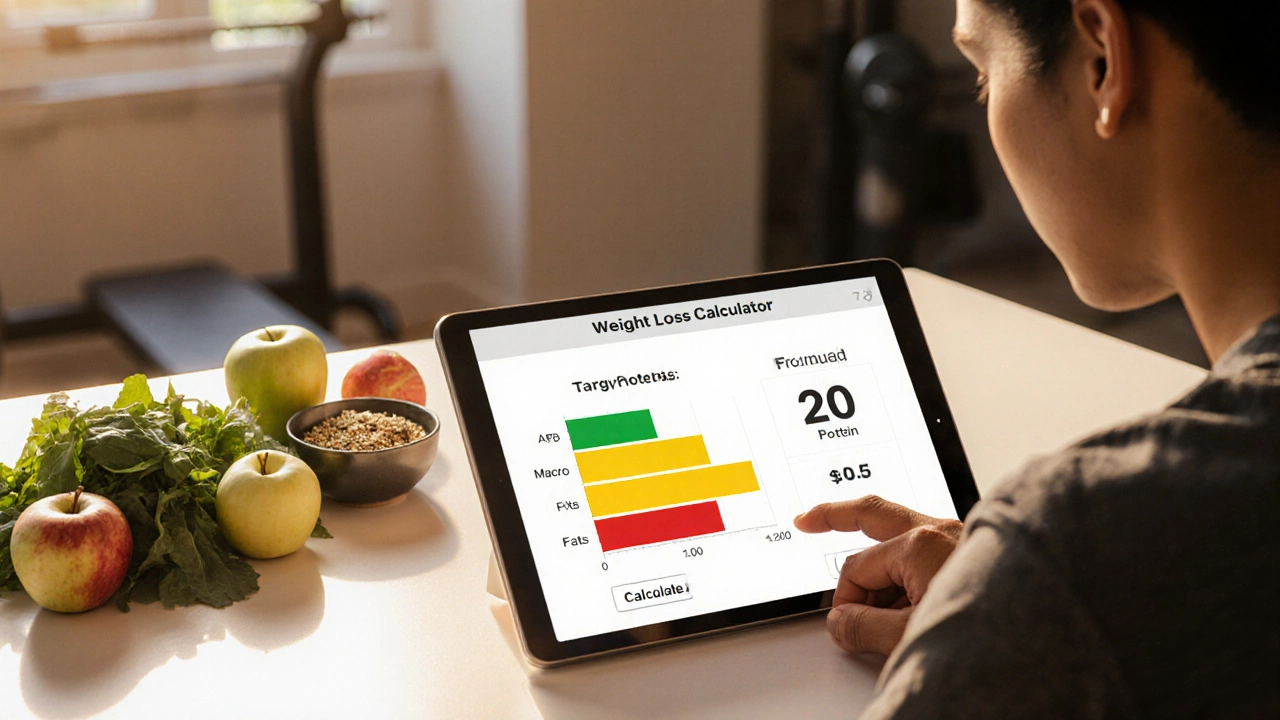20-Pound Weight Loss Calculator
Daily Calorie Target
-- kcal
Macronutrient Breakdown
This calculator estimates your daily calorie needs and macronutrient targets based on your personal information and activity level.
- Maintenance Calories: Estimated using the Mifflin-St Jeor equation
- Daily Deficit: 500-750 kcal to achieve 1-1.5 lb/week weight loss
- Protein Target: 1.2-1.5g/kg body weight
- Fat Target: 0.8-1g/kg body weight
- Carb Calculation: Remaining calories after protein and fat
lose 20 pounds in just three months sounds aggressive, but with the right numbers, habits, and mindset it’s doable for most healthy adults. Below is a no‑fluff roadmap that tells you exactly what to eat, how to move, and what to watch out for.
TL;DR - Quick Hit Checklist
- Create a daily calorie deficit of 500‑750kcal.
- Eat 1.2‑1.5g protein perkg body weight.
- Combine 3‑4sessions of HIIT with 2‑3strength‑training days each week.
- Prioritize 7‑9hours of sleep and manage stress.
- Track progress weekly and adjust calories every 2weeks.
Understanding the Numbers
Weight loss is the reduction of total body mass, primarily fat, achieved through a sustained calorie deficit combined with lifestyle changes. One pound of body fat roughly equals 3,500kcal, so shedding 20lb means a total deficit of about 70,000kcal over 90days - roughly 778kcal per day. A safe daily gap of 500‑750kcal still yields ~1‑1.5lb loss per week, leaving room for daily energy fluctuations and adherence.
Calculating Your Personal Calorie Target
Step1: Estimate your maintenance calories using the Mifflin‑St Jeor equation.
- For men: 10×weight(kg) + 6.25×height(cm) - 5×age + 5
- For women: 10×weight(kg) + 6.25×height(cm) - 5×age - 161
Step2: Multiply by an activity factor (1.2=sedentary, 1.55=moderately active, 1.9=very active). Step3: Subtract 500‑750kcal to set your daily target.
Example: A 30‑year‑old woman, 65kg, 165cm, moderately active. Maintenance ≈ 1,460kcal ×1.55 ≈ 2,260kcal. Target = 1,560kcal (500kcal deficit). This will average ~1lb loss per week.
Macro‑Smart Eating
Macronutrients are the three main nutrient groups - protein, carbohydrates, and fats - that provide calories and support body functions. For fat loss, keep protein high to preserve muscle, moderate carbs for energy, and keep fats reasonable.
- Protein: 1.2‑1.5g perkg body weight (≈78‑98g for a 65kg person). Provides ~4kcal/g.
- Fats: 0.8‑1g perkg (≈50‑65g). ~9kcal/g.
- Carbs: Fill the remaining calories.
Sample 1,560kcal day:
- Protein: 100g=400kcal
- Fat: 55g=495kcal
- Carbs: 166g=665kcal
Meals can be built around lean meats, low‑fat dairy, whole grains, legumes, fruits, and plenty of non‑starchy veg.
Exercise Blueprint
High‑Intensity Interval Training (HIIT) is a cardio method alternating short bursts of maximal effort with brief recovery periods, maximizing calorie burn in limited time. HIIT spikes metabolism for up to 24hours post‑workout (the “afterburn” effect).
Sample weekly schedule (45min each session):
- Monday: 20‑minute HIIT (e.g., 30s sprint/30s walk ×10) + 5min warm‑up/cool‑down.
- Tuesday: Full‑body strength (compound lifts - squats, deadlifts, push‑ups) - 3sets×8‑12reps.
- Wednesday: Active recovery - brisk 30‑min walk or yoga.
- Thursday: HIIT (cycling or rowing) - 20min.
- Friday: Upper‑body strength - bench press, rows, shoulder press.
- Saturday: Long‑slow cardio (45‑60min) - jogging, swimming.
- Sunday: Rest.
Strength training builds muscle, which raises resting metabolic rate and helps preserve lean mass during calorie restriction is non‑negotiable for a sustainable 20‑lb drop.

Beyond Food and Fitness: Sleep, Stress, and Metabolism
Sleep is the nightly restorative process that regulates hormones like ghrelin (hunger) and leptin (satiety). Aim for 7‑9hours; poor sleep can increase appetite by up to 20%.
Stress triggers cortisol release, which can promote abdominal fat storage and cravings for sugary foods. Incorporate daily stress‑busting habits: meditation, deep‑breathing, short walks, or a hobby.
Metabolism refers to the sum of chemical reactions that convert food into energy, heavily influenced by muscle mass, hormones, and activity level. Keeping muscle through strength work and staying active preserves metabolic rate.
Choosing a Meal‑Planning Approach - Quick Comparison
| Strategy | Core Idea | Typical Deficit | Ease of Tracking | Best For |
|---|---|---|---|---|
| Calorie Counting | Log every bite, stay within target kcal | 500‑750kcal | High (apps) | Data‑lovers, flexible eaters |
| Low‑Carb (e.g., Keto) | Limit carbs <50g/day, higher fat | 600‑800kcal | Medium (macro‑tracker) | Those who enjoy meat &fat |
| Intermittent Fasting (16/8) | Eat only within an 8‑hr window | 400‑600kcal (natural reduction) | Low (no counting) | Busy schedules, night‑owls |
Pick the one that feels least restrictive; consistency beats perfection.
Tracking, Tweaking, and Staying Motivated
Use a simple spreadsheet or an app to log:
- Daily calories and macros.
- Weight (same time, same scale).
- Workout type, duration, and RPE (Rate of Perceived Exertion).
Every 14days, compare average weekly loss. If you’re losing less than 0.5lb per week, shave another 100‑150kcal off your target. If you’re dropping >2lb a week, add back 100kcal to protect muscle.
Motivation tricks:
- Take progress photos every two weeks - visual proof trumps numbers.
- Reward milestones with non‑food treats (new shoes, massage).
- Find an accountability buddy or join a supportive online group.
Common Pitfalls and How to Dodge Them
- Over‑restricting calories: Falling below 1,200kcal (women) or 1,500kcal (men) can trigger hormonal slowdown.
- Skipping strength work: Leads to muscle loss, making future maintenance harder.
- Ignoring liquid calories: Sugary drinks, alcohol, and fancy coffee can add 300‑500kcal unnoticed.
- Inconsistent sleep: Even one night of <5hours can raise ghrelin by 15%.
- All‑or‑nothing mindset: One cheat day won’t ruin progress; it can reset hormones.
When to Seek Professional Help
If you have any medical conditions (diabetes, thyroid issues, heart disease) or take medication that influences weight, consult a doctor or a registered dietitian before starting. They can tailor calorie targets and ensure nutrient adequacy.
Putting It All Together - 3‑Month Action Plan
- Week1‑2: Calculate maintenance, set target calories, buy a food scale, and log everything.
- Week3‑4: Add 3 HIIT sessions and 2 strength days. Adjust macros to hit protein goal.
- Month2: Review weight trend. If loss <0.5lb/week, reduce calories by 100kcal. Start a weekly 30‑minute walk for active recovery.
- Month3: Fine‑tune portion sizes, incorporate intermittent fasting if desired, and focus on sleep hygiene (no screens 1hour before bed).
- Final week: Celebrate with a non‑food reward, take before‑after photos, and plan a maintenance calorie level (maintenance+200kcal).
Stick to the numbers, move daily, and keep stress low - you’ll be on track to drop those 20lb in 90days.

Frequently Asked Questions
Can I lose 20lb faster than 3 months?
Rapid loss (>2lb/week) often means losing water and muscle, not just fat, and can raise health risks. A slower, steady approach is more sustainable and preserves muscle.
Do I need to count every calorie?
Counting works for many, but you can also use portion‑control plates, the “hand‑method” for protein/fats/carbs, or adopt intermittent fasting. The key is maintaining an overall deficit.
How much cardio is enough?
Three 20‑minute HIIT sessions plus one longer low‑intensity cardio day (45‑60min) give good calorie burn without overtraining.
What if I hit a weight‑loss plateau?
Plateaus are normal. Try tightening your calorie goal by 100kcal, switch up workout intensity, or add a day of strength training to boost metabolism.
Is it safe to diet while doing strength training?
Yes, as long as protein intake is sufficient (1.2‑1.5g/kg) and calorie deficit isn’t extreme. This protects muscle and keeps strength gains.





